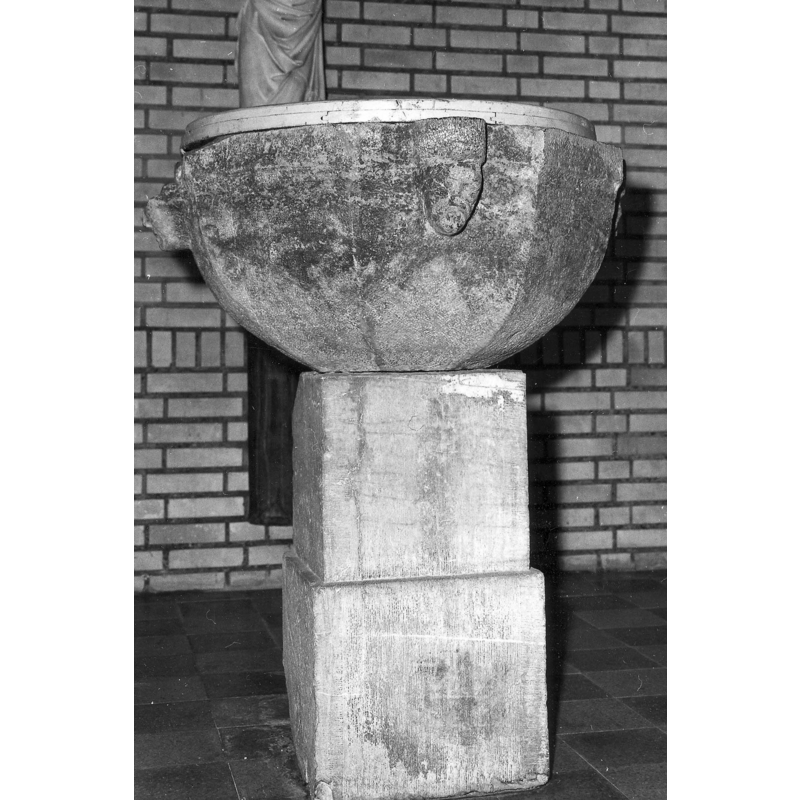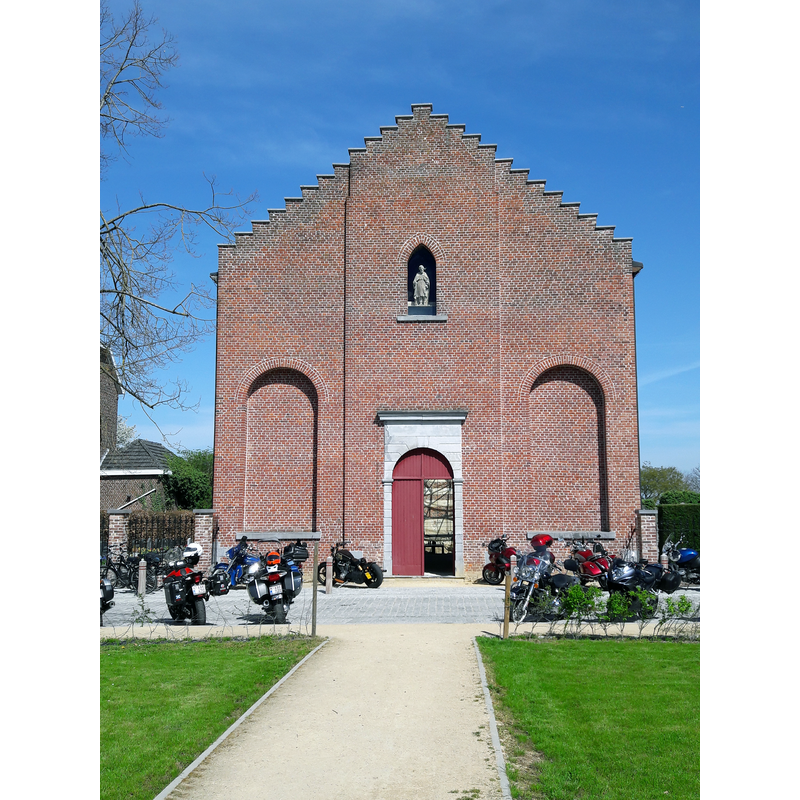Ulbeek / Ulen

Image copyright © KIK-IRPA, Brussels (Belgium), 2024
CC-BY-4.0
Results: 4 records
human figure - head - 4
view of church exterior - southwest view
Scene Description: Source caption: "[Nieuwe] Sint-Rochuskerk in Ulbeek"
Copyright Statement: Image copyright © Sonuwe, 2007
Image Source: digital photograph 27 July 2007 by Sonuwe [https://commons.wikimedia.org/wiki/File:Ulbeek_-_Sint-Rochuskerk.jpg] [accessed 28 April 2024]
Copyright Instructions: GFDL / CC-BY-SA-3.0
view of church exterior - west view
Scene Description: Source caption: "Oude Sint-Rochuskerk. Ontwijd en met opgewerkt dak. Thans gebruikt als begraafplaats en archeologische site. Zie wikipedia "Sint-Rochuskerk (Ulbeek)"" -- in use as a cemetery and archeological site
Copyright Statement: Image copyright © Bert76, 2018
Image Source: digital photograph 17 April 2018 by Bert76 [https://commons.wikimedia.org/wiki/File:Oude_Sint-Rochuskerk_1.jpg] [accessed 28 April 2024]
Copyright Instructions: CC-BY-SA-4.0
view of font and cover
INFORMATION
FontID: 25470ULE
Object Type: Baptismal Font1 (basin only)
Church/Chapel: Nieuwe Sint-Rochuskerk Ulbeek
Church Patron Saints: St. Roch [aka Roc, Roche, Rock, Roque]
Church Location: Ulbeekstraat 32, Ulbeek, 3832 Wellen, Belgium
Country Name: Belgium
Location: Limburg, Vlaanderen / Flandres
Directions to Site: Located off (E) the N767 [aka Ulbeekstraat] in the municipality of Wellen, about 10 km SSW of Hasselt [NB: the two churches are about 250 m. appart]
Ecclesiastic Region: Diocèse de Hasselt
Font Location in Church: Inside the new church
Date: n.d.
Century and Period: 13th century [basin only], Gothic [altered]
Workshop/Group/Artisan: Mosan font
Credit and Acknowledgements: We are gratefult to Pol Herman for bringing this font to our attention and for his help in documenting it
Font Notes:
Click to view
Baptismal font from the old church listed and illustrated in BALaT KIK-IRPA [https://balat.kikirpa.be/object/80095] [accessed 28 April 2024]: "Kerk Sint-Rochus[Ulbeek] [...] doopvont [...] hardsteen [...] Date: 1201 (onzeker) - 1400 (onzeker)" [NB: the KIK-IRA entry cites "C. Ceulemans en R. Didier, Inventaris van de gotische figuratieve beeldsnijkunst uit de periode 1380-1550, bewaard in Belgisch Limburg, (tent. cat. Sint-Truiden, 1990), nr. 632." as reference]. The entry for this church in the Belgian Wikipedia [https://nl.wikipedia.org/wiki/Sint-Rochuskerk_(Ulbeek)] [accessed 28 April 2024] mentions that a Gothic baptismal font made of bluestone in the 13th century ["de 13e-eeuwse vroeggotische doopvont in arduin"], originally from the old church was moved to the new building. The entry for the new church in the Belgian Wikipedia [https://nl.wikipedia.org/wiki/Nieuwe_Sint-Rochuskerk_(Ulbeek)] [accessed 28 April 2024] describes the font in it as second quarter of the 16th-century, decorated with four heads; the base and the cover, modern ["Het doopvont stamt uit het tweede kwart van de 16e eeuw. Het toont vier hoofden. De sokkel en het deksel zijn nieuw"].
A communication to BSI from Pol Herman (e-mail of 24 February 2024) notes: "The old Saint-Rochus church at Ulen has been used until 1938, after which it was replaced by the newly built Saint-Rochus church, that is located 250m away. There is a damaged basin of a mosan limestone font, with 4 heads. KIK-IRPA dates the baptismal font 12-14th century. Wikipedia says : second quarter 16th century (on the website of the new church) and 13th century (on the website of the old church). My opinion : it is 13thC. The old church was used as factory building and as storage room for a furniture company. By 1990, the village council wanted to demolish the ruined remains, but there was a lot of protest. It was decided to restore the building, and to use it as burial place. The restoration was finished in 2012. Archeological excavations in 1998 revealed the existing of a unknown older, Romanesque building. Mostly dated circa 1000. Ulbeek is mentioned for the first time in 1067, when bishop Theoduinus of Liège (1048-1075) bought it. A priest is mentioned in 1129. In the centre of the nave, on the axis, the foundation of a baptismal font were discovered. I could also be the foundation of a pillar, but there is no indication of the need for such pillar within the lay-out of the building. This find is in line with the hypothesis stated by Mona Bramer Solhaug in The architectural setting of baptism : rituals, norms and practices in Scandinavia : ca 1050- ca 1250." [NB: the identification of the foundation for the font is noted and illustrated in Elvira Knaepen's Archeologisch onderzoek in de oude kerk van Ulbeek / Wellen 1 juli 1998 -31 oktober 1998 o.l.v. archeoloog S. Bielen (voor de gemeente) en L. Van Impe (voor het IAP) [089723_Knaepen_E._2009.pdf] [accessed 28 April 2024]
COORDINATES
Church Latitude & Longitude Decimal: 50.842361, 5.306144
Church Latitude & Longitude DMS: 50° 50′ 32.5″ N, 5° 18′ 22.12″ E
UTM: 31U 662360 5634829
MEDIUM AND MEASUREMENTS
Material: stone, limestone
Font Shape: octagonal (mounted)
Basin Interior Shape: round
Basin Exterior Shape: octagonal
LID INFORMATION
Date: modern
Apparatus: no
Notes: round, flat and plain; modern
REFERENCES
KIK-IRPA, BALaT KIK-IRPA, 2024. Accessed: 2024-04-28 00:00:00. URL: https://balat.kikirpa.be/.
![Source caption: "[Nieuwe] Sint-Rochuskerk in Ulbeek"](/static-50478a99ec6f36a15d6234548c59f63da52304e5/compressed/1240428003_compressed.png)
